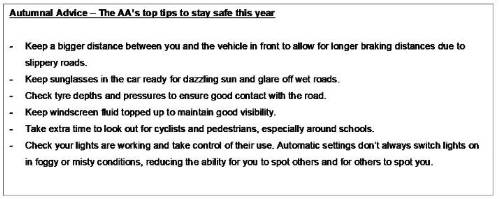The AA is advising drivers to be more vigilant ahead of the clocks going back an hour on Sunday 27 October, as crashes rise by 11% in the two weeks following the change. Collision data from The AA’s Accident Assist team saw calls for its service rise by 11% the fortnight after the 2023 October clock change compared to the fortnight before the clocks fell back.
Darker evenings, wet weather and slippery streets all contribute to increased collisions in late October and early November. Even when autumn produces drier, sunnier days, drivers are struggling with low-lying sun and glare off the roads. Last month, three quarters (73%) of drivers said the worst thing about driving in autumn was being dazzled by the sun. More than half (52%) said other drivers not using their lights properly is a problem in autumn, while two fifths (40%) said darker mornings and evenings were the worst aspect of autumnal motoring.
According to the 2023 road casualty statistics, there were 3,680 collisions where someone was injured or killed due do the driver’s vision was affected by adverse weather or dazzling sun. Similarly, there were 4,244 injury collisions where the road surface was slippery due to weather conditions. AA Accident Assist is reminding drivers to carry out some basic vehicle checks such as checking tyres and lights, as well as ensuring they carry sunglasses throughout the season to combat low and dazzling sun.

The AA has also partnered with the FIA’s School Road Safety campaign, reminding drivers to be extra cautious when driving near schools at drop off and pick up times.
Tim Rankin, managing director of AA Accident Assist, said: “Our stats are clear that when the clocks fall back we see a rise in the number of crashes. Many of these could be avoided by making small changes to driving habits. “Dazzle by low-lying sun can make a journey challenging, but being in control of your lights is easy. Leaving the stalk on ‘auto’ is not always the best way forward. We urge drivers to help light the way to help them see others and help other see you. Arguably, driving in autumn is the most testing as the weather cam change from cold and wet, to bright and sunny. The best advice is to drive to the conditions, ensure your car is in good condition and to look out for other road users.”
|

